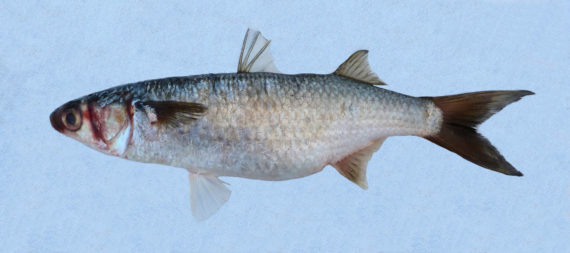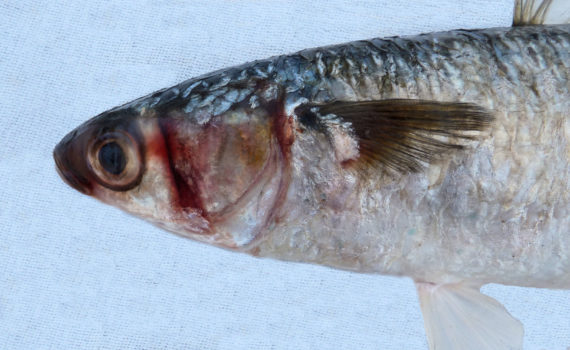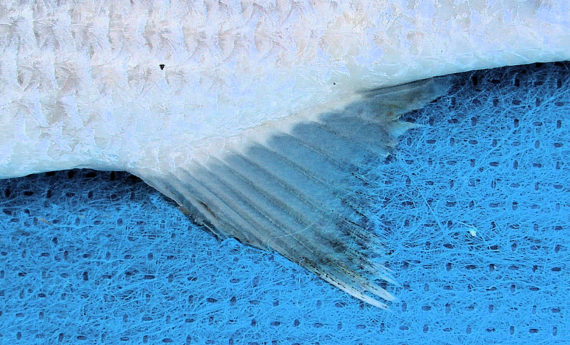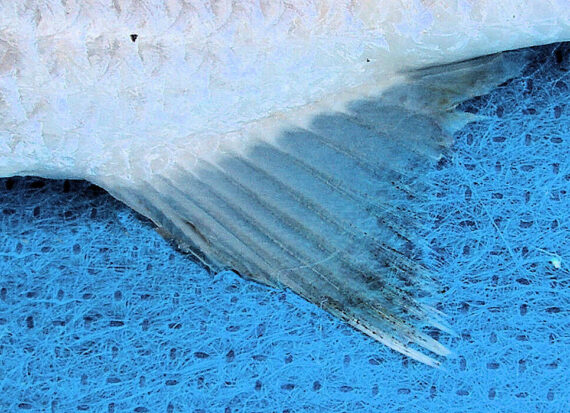White Mullet, Mugil curema
 White Mullet, Mugil curema. Fish caught in a cast net in coastal waters off Loreto, Baja California Sur, May 2019. Length: 25 cm (10 inches). Catch, photograph and identification courtesy of Chris Wheaton, Fullerton, California.
White Mullet, Mugil curema. Fish caught in a cast net in coastal waters off Loreto, Baja California Sur, May 2019. Length: 25 cm (10 inches). Catch, photograph and identification courtesy of Chris Wheaton, Fullerton, California.

 White Mullet, Mugil curema. Fish provided by the commercial fishermen of Puerto Adolfo Lopez Mateos, Baja California Sur, May 2017. Length: 30 cm (12 inches).
White Mullet, Mugil curema. Fish provided by the commercial fishermen of Puerto Adolfo Lopez Mateos, Baja California Sur, May 2017. Length: 30 cm (12 inches).
 White Mullet, Mugil curema. Anal fin with 3 spines and 9 rays, a key to the correct identification of this species. Fish provided by the commercial bait salesmen of Puerto Los Cabos, Baja California Sur, July 2014. Length: 30 cm (12 inches).
White Mullet, Mugil curema. Anal fin with 3 spines and 9 rays, a key to the correct identification of this species. Fish provided by the commercial bait salesmen of Puerto Los Cabos, Baja California Sur, July 2014. Length: 30 cm (12 inches).
 White Mullet, Mugil curema. Underwater photograph taken in coastal waters off Loreto, Baja California Sur, October 2024. Photograph courtesy of Bob Hillis, Ivins, Utah.
White Mullet, Mugil curema. Underwater photograph taken in coastal waters off Loreto, Baja California Sur, October 2024. Photograph courtesy of Bob Hillis, Ivins, Utah.
The White Mullet, Mugil curema, is a member of the Mullet or Mugilidae Family, that is known in Mexico as lisa blanca. Globally, there are fifteen species in the genus Mugil, of which seven are found in Mexican waters, three in the Atlantic, two in the Pacific, and two in both the Atlantic and Pacific Oceans.
The White Mullet has a very elongated body with a rounded cross section; their body depth is 20% to 22% of standard length. They are olive to bluish dorsally, silvery on their sides, and white ventrally. They have 6 dark stripes along their flank, a large black blotch on the base of their pectoral fin, and a medium-sized gold blotch on their gill covers. Their anal fin is transparent with a black margin, their second dorsal fin is dark, their pelvic fins are yellowish, and their other fins are transparent. Their head is broad, slightly wider than deep, and is 22% to 23% of standard length. They have a small terminal mouth with thin lips and a knob on the bottom of their lower lip. They have a blunt nose, prominent well-developed fatty eyelids with a small slit over their pupil, and front and rear nostrils that are widely separated. Their anal fin has 3 spines and 9 or 10 rays; their caudal fin is weakly forked; their first dorsal fin has 4 or 5 spines; and, their second dorsal fin has 8 or 9 rays; and, their pectoral fins are short and do not reach the origin of the first dorsal fin. Their body is covered with large scales. They do not have a lateral line.
The White Mullet is found near the surface over sandy bottoms in shallow coastal waters and estuaries at depths up to 24 m (80 feet); they also venture into adjacent fresh water. They reach a maximum of 91 cm (3 feet 0 inches) in length with males and females being of equal size. As of January 1, 2024, the International Game Fish Association world record stood at 0.68 kg (1 lb 7 oz) with the fish caught in coastal waters off Rio de Janeiro in April 2001. They travel in enormous schools and feed primarily on algae, zooplankton, and dead plant matter making them an important ecological waste processing machine. They are preyed upon by birds, fish, and various other marine mammals. They are known for leaping out of the water frequently, which is believed to generate oxygen. Reproduction is oviparous with females laying between 1,000,000 and 5,000,000 eggs annually that are fertilized externally by males. The eggs are pelagic and non-adhesive. They have lifespans of up to sixteen years.
The White Mullet is found in all Mexican waters of both the Atlantic and the Pacific Oceans.
The White Mullet is virtually identical to, and easily confused with, the Striped Mullet, Mugil cephalus (darker coloration; 8 anal rays; black blotch at base of pectoral fin). It is also similar to the Liseta Mullet, Mugil setosus (blunt head profile; deeply concave anal and second dorsal fins; longer rounded pectoral fins).
From a conservation perspective the White Mullet is currently considered to be of Least Concern with stable, widely distributed populations. They are an important commercial species that are caught with cast nets, lift nets, stake nets, trammel nets, beach seines, hook and line and fish corrals. They are marketed year round in all Mexican Food Markets fresh, frozen and salted for human consumption. The roe is sold fresh or smoked. Juveniles are utilized as a live bait fish. They are also processed into fish oil. In the states of Tabasco and Vera Cruz they are raised via aquaculture for human food. Mexico is one of the top ten global countries for mullet with annual production at the level of 12,000 tons per year. The White Mullet is a filter feeder and as such cannot be caught with hook and line via traditional methods. They show up in June and July along the southern coasts of Baja by the millions attracting the famous Roosterfish. They are caught either via cast nets or snagging with heavily weighted treble hooks with surf casting gear. They are one of the important commercial live baits of the greater Los Cabos area during the summer months and are fly-lined live targeting one of the world’s true exotics, the Roosterfish, as well as Dorados, Groupers and Snappers. They can also be used as effective cut bait or for chum.
 Anal fin of Striped Mullet, Mugil cephalus
Anal fin of Striped Mullet, Mugil cephalus
 Anal fin of White Mullet, Mugil curema
Anal fin of White Mullet, Mugil curema